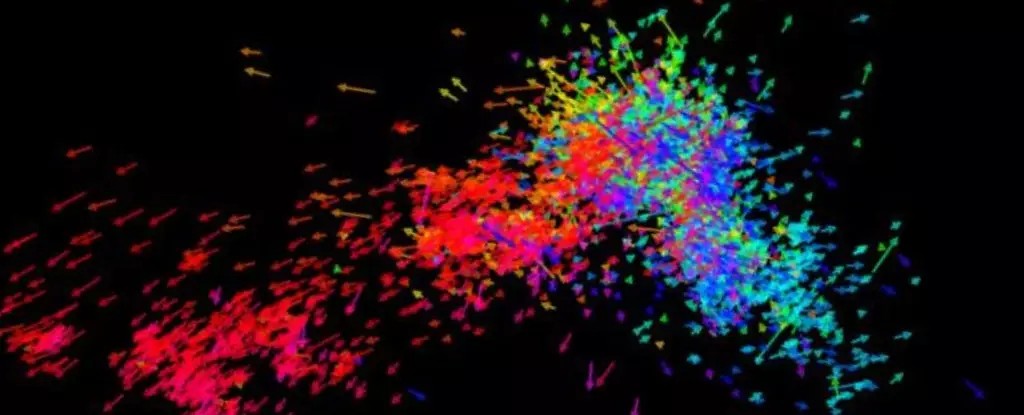The Magellanic Clouds, two captivating dwarf galaxies visible from the Southern Hemisphere, have long been a subject of fascination for astronomers and stargazers alike. Named after the adventurous 16th-century explorer Ferdinand Magellan, these galaxies—comprising the Large Magellanic Cloud (LMC) and the Small Magellanic Cloud (SMC)—are not just historical landmarks in the night sky but also pivotal players in the cosmic ballet of the universe. Situated approximately 160,000 and 200,000 light-years from Earth, the Magellanic Clouds are rich in gas and young stellar populations, making them invaluable laboratories for studying astrophysical phenomena. Recent groundbreaking research from Nagoya University has revealed surprising new dimensions to their behavior, particularly that of the SMC, which is now thought to be under severe gravitational stress from its larger neighbor, the LMC.
Unraveling Gravitational Forces
The researchers, led by Satoya Nakano and Kengo Tachihara, turned their attention to the movements of approximately 7,000 massive stars within the SMC. This cohort of stars, each exceeding eight times the mass of our Sun, serves as active markers within the hydrogen-rich regions of the galaxy. Their study unveiled a shocking dynamic: some massive stars within the SMC were seen to be racing towards the LMC, while others veered away, pointing to an unsettling gravitational influence at play. The implications of this are significant. It suggests that the SMC is not merely a passive satellite of the Milky Way; instead, it appears to be in a precarious state, potentially on the verge of being torn apart by the gravitational forces exerted by the LMC.
This study certainly redefines our understanding of galactic interactions. Historical models have often depicted such relationships in more simplistic terms, overlooking the complex dance of attraction and destruction that can occur as galaxies interact. The researchers’ findings not only corroborate the theory of tidal forces leading to the trailing Magellanic Stream—a plummet of intergalactic gas drifting into the Milky Way—but they also add depth to our comprehension of how these isolated galaxies are inexorably pulled into the gravity well of larger bodies.
A Paradigm Shift in Galactic Dynamics
Perhaps even more surprising than the gravitational findings was the observation regarding the rotational movement of the stars in the SMC. Unlike the orderly rotation observed in our Milky Way, where stars and gas clouds typically revolve in harmony, the massive stars in the SMC displayed erratic and non-rotational patterns. This lack of cohesive movement among its stellar inhabitants is extraordinary. It insinuates that the gas clouds, which typically serve as nurseries for young stars, may not be rotating at all. This critical finding raises essential questions about the formation and evolution of galaxies and indicates that some of the fundamental assumptions about galactic dynamics need re-evaluation.
Nakano and his team suggest that these revelations could necessitate a significant rethink of the calculations concerning the SMC’s total mass. As the interplay of gravitational forces among the SMC, LMC, and even our own Milky Way comes into sharper focus, it offers a more nuanced perspective on their interconnectedness. This could also mean that the SMC serves as a unique window into the conditions of early galaxies in the Universe, showing how interactions might have shaped the cosmos as we know it.
Connecting the Dots in Cosmic Evolution
These insights into the SMC’s structure and behavior carry far-reaching implications that extend beyond mere academic curiosity. The research encourages a reconceptualization of how we view galaxy formation and evolution itself. Given the SMC’s similarities to primordial galaxies, studying its dynamics offers a unique opportunity to understand the processes that governed the early universe. As scientists continue to track the movements of stars within this celestial entity, they can better connect the dots between star formation and the broader evolutionary theories concerning galaxy interaction.
Ultimately, the Nagoya University research is a testament to the dynamic and often fragile nature of our universe. Each study uncovers more layers of complexity in these celestial entities, compelling us to reconsider and refine our models of how such systems operate. The fate of the Small Magellanic Cloud serves as a reminder of the incredible forces at play in the universe and the ongoing quest to unlock its many mysteries. The cosmic narrative is far from complete; with each discovery, we draw closer to a profound understanding of the universe’s intricate tapestry.

